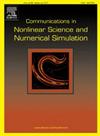准周期强迫圆映射中的共振与弱混沌
IF 3.4
2区 数学
Q1 MATHEMATICS, APPLIED
Communications in Nonlinear Science and Numerical Simulation
Pub Date : 2024-12-27
DOI:10.1016/j.cnsns.2024.108562
引用次数: 0
摘要
本文利用加权Birkhoff平均(WBA)对准周期强迫(QPF)圆映射的四类动力学进行了区分:共振和不相称规则动力学,强混沌和弱混沌动力学。规则轨道可以通过它们的旋转向量进行分类,并且这些可以使用WBA快速计算到机器精度。这些轨道可以是共振的,也可以是不相称的,我们通过计算它们的“共振阶数”来区分它们,使我们能够快速识别和观察大量阿诺德舌的几何特性。当动态为混沌时,WBA收敛缓慢。非规则轨道可以是强混沌的,当它们有一个正的李雅普诺夫指数时,或者当最大李雅普诺夫指数不为正时,弱混沌的。后者对应于从Ding、Grebogi和Ott引入的模型开始,在QPF圆映射中观察到的奇怪的非混沌吸引子(SNA)。WBA提供了一种高效的寻找sna的新技术,并使我们能够准确地计算出四种轨道类型中每一种的比例作为地图参数的函数。本文章由计算机程序翻译,如有差异,请以英文原文为准。
Resonance and weak chaos in quasiperiodically-forced circle maps
In this paper, we distinguish between four categories of dynamics for quasiperiodically-forced (QPF) circle maps: resonant and incommensurate regular dynamics, and strongly and weakly chaotic dynamics, using the weighted Birkhoff average (WBA). Regular orbits can be classified by their rotation vectors, and these can be rapidly computed to machine precision using the WBA. These orbits can be resonant or incommensurate and we distinguish between these by computing their “resonance order,” allowing us to quickly identify and observe the geometric properties of a large set of Arnold tongues. When the dynamics is chaotic the WBA converges slowly. Orbits that are not regular can be strongly chaotic, when they have a positive Lyapunov exponent, or weakly chaotic when the maximal Lyapunov exponent is not positive. The latter correspond to the strange nonchaotic attractors (SNA) that have been observed in QPF circle maps beginning with models introduced by Ding, Grebogi, and Ott. The WBA provides an efficient new technique to find SNAs, and allows us to accurately compute the proportions of each of the four orbit types as a function of map parameters.
求助全文
通过发布文献求助,成功后即可免费获取论文全文。
去求助
来源期刊

Communications in Nonlinear Science and Numerical Simulation
MATHEMATICS, APPLIED-MATHEMATICS, INTERDISCIPLINARY APPLICATIONS
CiteScore
6.80
自引率
7.70%
发文量
378
审稿时长
78 days
期刊介绍:
The journal publishes original research findings on experimental observation, mathematical modeling, theoretical analysis and numerical simulation, for more accurate description, better prediction or novel application, of nonlinear phenomena in science and engineering. It offers a venue for researchers to make rapid exchange of ideas and techniques in nonlinear science and complexity.
The submission of manuscripts with cross-disciplinary approaches in nonlinear science and complexity is particularly encouraged.
Topics of interest:
Nonlinear differential or delay equations, Lie group analysis and asymptotic methods, Discontinuous systems, Fractals, Fractional calculus and dynamics, Nonlinear effects in quantum mechanics, Nonlinear stochastic processes, Experimental nonlinear science, Time-series and signal analysis, Computational methods and simulations in nonlinear science and engineering, Control of dynamical systems, Synchronization, Lyapunov analysis, High-dimensional chaos and turbulence, Chaos in Hamiltonian systems, Integrable systems and solitons, Collective behavior in many-body systems, Biological physics and networks, Nonlinear mechanical systems, Complex systems and complexity.
No length limitation for contributions is set, but only concisely written manuscripts are published. Brief papers are published on the basis of Rapid Communications. Discussions of previously published papers are welcome.
 求助内容:
求助内容: 应助结果提醒方式:
应助结果提醒方式:


